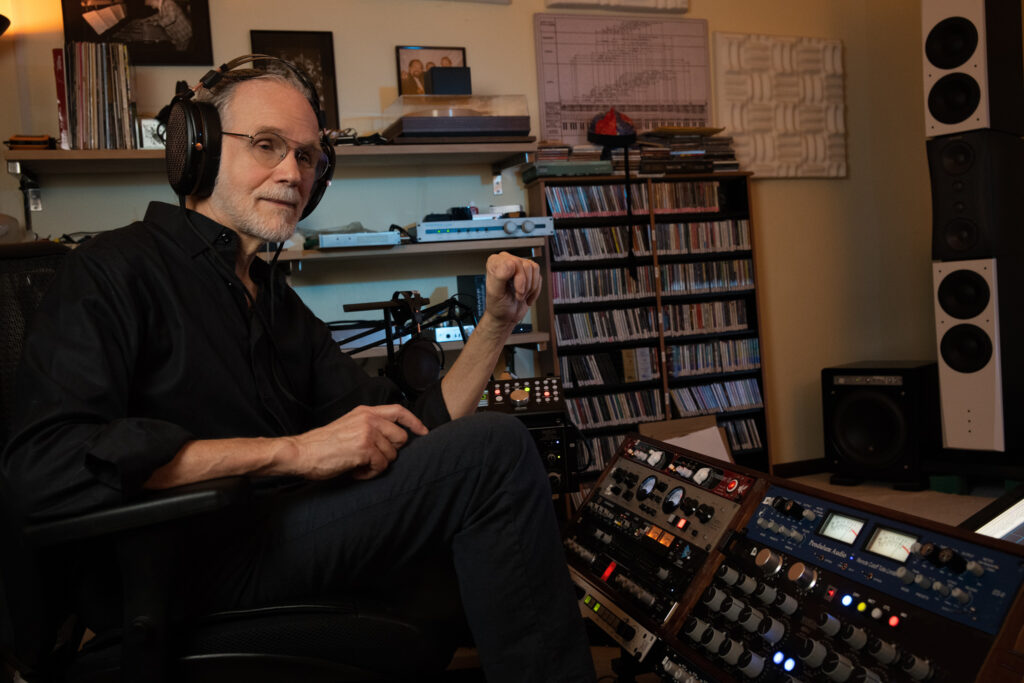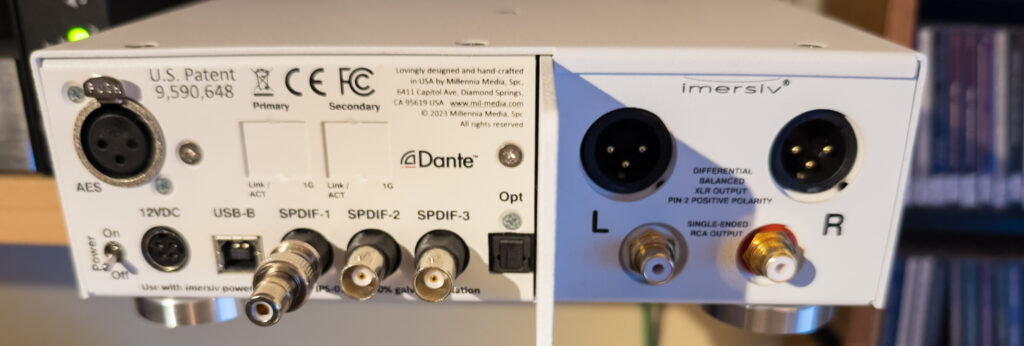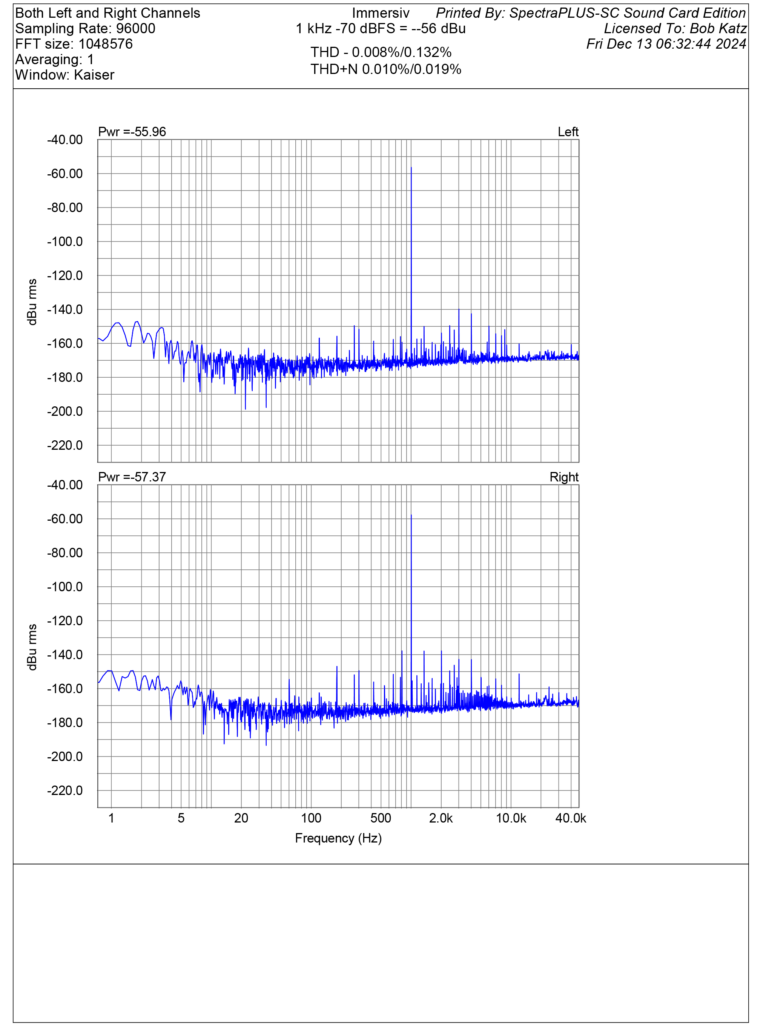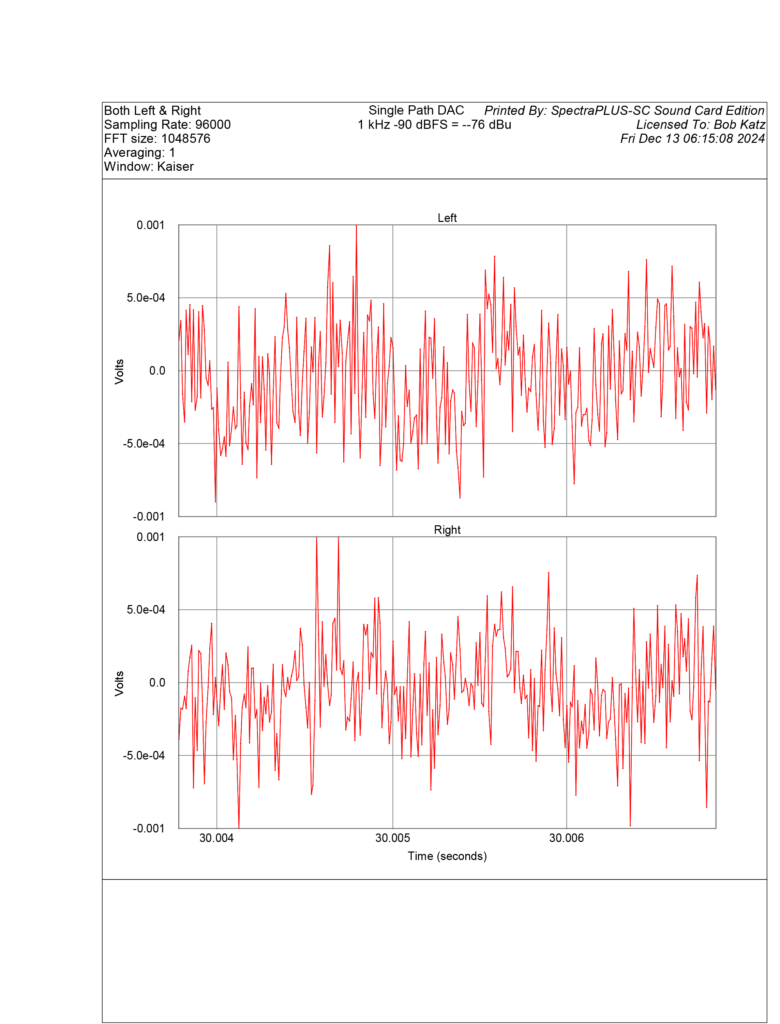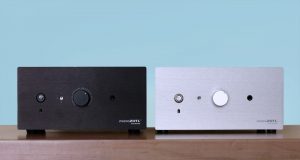Bob Katz at work wearing the Audeze CRBN 2 Headphones, a portrait. (Photograph by Mary Kent.)
Introduction
Today I'm reviewing two remarkable products, both of which represent a new audio paradigm and a veritable redefinition of the state of the art! I know, this is an old audio cliché, but in this case I think the hyperbole is justified. Read on…
DAC Technology and Real World Signals
As the years have marched on, the quality of the chips used in Digital To Analog Converters (DACs) has improved so much that a good DAC can now be produced (in China) for under $100! One example is the SMSL model SU-1, which I recently purchased (but not the prime subject of this review). The SU-1 sounds very good, has all the usual bells and whistles except for balanced outputs: 32-bit audio, 768kHz PCM over USB, 192kHz audio over S/PDIF, DSD512, and MQA. Makes you wonder whether $1000+ DACs sound 10 times better than the SU-1. Frankly I am bored by modern DAC after DAC sounding more alike than different. Because the dirty little design secret is that all DACs are limited in sound quality by the quality of the chips within, no matter how they slice them. (Spoiler alert: until now!).
Let me summarize the current state-of-the-art DAC, what I call a "standard DAC." A standard DAC employs a single digital path from source to the DAC circuit. Some expensive standard DACs use discrete circuits or resistive ladders and avoid integrated circuit DAC chips but there is always a single digital path from digital source to DACs. It turns out that a single digital path limits the low level distortion and noise performance of the converter, as I will demonstrate in the measurement section. Some standard DACs use 32-bit chips and they parallel or push-pull the chips to eke out a small improvement in noise and dynamic range, beating -120 dBFS noise by a small margin, but still use only a single digital path from source to the converter(s). One high quality manufacturer uses 4 channels of a chip per left or right channel and achieves a measurable SNR improvement somewhat better than ‑120 dBFS.
But is an improvement circa -120 dBFS really audible? Fact: The low levels of music, room noise and reverb decays in a quality classical recording typically live at not much lower than -50 dBFS. If we consider full peak level to be a shout, then -50 dBFS is a whisper! Yet this -50 whisper is a full 70 dB above the nominal -120 dBFS noise floor of a standard DAC. 70 dB is a significant margin, allowing the lowest signal, reverberation or room tone to be well above the DAC noise. 70 dB is a big shout to whisper ratio in addition to the first shout to whisper ratio! So the DAC noise floor is inaudible: two shout-whisper ratios below the very top signal! If you think you can hear DAC noise, it's like claiming you can hear a mosquito landing on the window in the next room. DAC noise floor around -120 dBFS is masked by any and all recording's noise and mike preamp noise. Despite that, some advanced manufacturers have been pushing the envelope down toward -130 dBFS noise. Honestly, this is just a numbers game: improving noise floor from -120 to -130 dBFS is overkill on top of overkill, well below perceptibility under any circumstance, no matter how extreme the music's dynamic range. To the ear, any noise from say, -100 dBFS on down is totally silent, at normal monitor gains with a quiet monitor system. I don't mind practicing overkill, of course, I just want us to put this numbers race in perspective.
If we normalize full scale digital to 110 dB SPL (very loud), the noise floor of the quietest standard DAC would be below -10 dB SPL, in other words, imperceptibly quiet. The noise floor of the quietest concert hall, when empty of people, may be around 20 dB SPL (depending on the weighting/measurement method), but more typically 30 or perhaps 40 dB SPL. This room noise is arguably enough to mask the already imperceptible -10 dB SPL noise floor of the DAC. If you turn up your monitor gain, all you hear is recorded room tone, not DAC noise.
What about audiophile recordings with extreme dynamic range? Doesn't the DAC noise maybe affect our perception? Has anyone made a recording in a quiet hall of an acoustic ensemble that can produce 100 dB SPL on peaks, yet in the pauses expect the musicians and the air conditioning and the mikes and the preamps to be as low as, say, 20 dB SPL? That would be a very extreme 80 dB recorded peak signal to RMS noise ratio. That mythical recording is almost impossible to achieve, in a world where the best classical music recordings present "only" 40‑50‑60 dB dynamic range from full peak signal to termination of reverberation (which is still amazingly dynamic).
Let's imagine the world's rarest recording, made in the world's quietest room, with musicians not moving a muscle in a pause. Would you be able to enjoy the purity of this recording in your listening room? Most listening rooms are simply not quiet enough to appreciate that once-in-a-lifetime recording. And if your room is remarkably that quiet, make sure you don't move a muscle yourself or you'll cover that perfectly silent background. That's how quiet this mythical recording has to be. But how low is the "perfectly silent background" of that world's rarest recording?
I have discovered just one candidate of the rarest of rare music recordings, which has the most extreme peaks and very low noise. So I measured its noise floor: In the pauses, it's -75 dBFS unweighted RMS, consisting of negligible preamp hiss and a little bit of 180Hz hum. -75 is a whole 45 dB above the noise floor of a quiet DAC. Another shout versus whisper ratio! I don't know the origin of this incredible recording; it was sent to me without much identification. I would love for someone to identify it, give the musicians a bow and us a chance to purchase it. I will tell you more about this unknown recording during the listening tests.
What about 32-bit versus 24-bit, since 32-bit is the new buzz word? All DACs until recently employed 24-bit chips. 24-bit digital numbers encode 144 dB of signal difference while 32-bit can encode 192 dB. The noise floor of the best 24-bit chips is around 19- 20-bits (-120 dBFS). The noise floor of the 32-bit chips can be better, but not by much, as I mentioned. Despite that, a 32-bit DAC can receive data as low as -192 dBFS! Of course that's well below the noise floor of any DAC technology. So what's the fuss about 32-bit? Is it just another numbers game? Well, there is an advantage to having a 32-bit DAC, but it's not signal to noise ratio per se. It's the ability to have 32-bit communication between player and DAC: Your music player can digitally attenuate signal and send high quality 32-bit data to a DAC without losing resolution. So 32-bit communication enables a realizable, uncompromised digital volume control. That's the primary advantage of 32-bit.
In summary, while these multi chip improvements increase dynamic range from 120 to as much as 130 dB, that does nothing for audibility! Spoiler alert: until now!
Introducing the imersiv D1 DAC
In the fall of 2023, pro manufacturer Millennia Media introduced a new brand, called imersiv, and its first product, the D1. Triple patented, the D1 employs a new, multi-path architecture to achieve a claimed breakthrough dynamic range performance of greater than 162 dB, broadband, unweighted. I'll wait a minute while you let that jaw- dropping number sink in. But wait another minute: I have just told you that SNR improvements below -120 dBFS are not audible. And I believe this is still true. So what's special about the technology behind the imersiv D1 and why could it sound audibly and meaningfully better?
It took Millennia Media ten years to reach this point. The D1 employs two DAC chips, but not in a standard way.
Instead, one chip covers high level signals, and the other covers low level signals. There are two digital paths from source to the DAC chips. A sophisticated DSP algorithm invisibly (hopefully) crossfades between the low and high level DAC. The crossfade point between the high and low levels is being finalized and the firmware of the D1 is currently in Beta. Low level signals operate near the most significant bit (MSB) of the low level DAC, where distortion is much lower. Therefore the low level performance of multi-path is much better than that of a single-path to DAC chip(s). Better than the performance of all other DACs made today! Millennia's technique is called multi-path Technology. It is new to DACs, but some current Analog to Digital Converters (ADCs) already employ multi-path. At low levels, the distortion of all other DACs is significantly higher than that of the D1, regardless of how many chips those manufacturers employ in their architecture. According to Millennia's John La Grou, the D1 is a breakthrough new audio paradigm for DACs, with claimed specs:
- Dynamic range: >170 dB Linearity: >170dB
- Broadband/Unweighted Noise: -146 dBu
- True Digital Performance: >28-bits
This is over 100x greater performance than any other DAC made today.
But as I said, I don't think these breakthrough specs, while remarkable, tell the real story why the imersiv multi-path architecture could sound better than every other DAC made today. The real key is this: Millennia's diagram of the difference in THD+N performance between multi-path and a single-path DAC (Fig. 1).
Fig 1: Compare THD+N of single-path vs. multi-path DAC
This conceptual illustration shows that at low levels below about -30 dBu, the distortion plus noise (THD+N) of the D1 is significantly lower than that of a standard DAC. The kink in the blue portion of the graph represents the crossfade point between the high and low level DAC chip. Millennia's La Grou says that the ambience, spatiality and depth of audio material live at the low level points. Above the crossfade point, the distortion and signal to noise ratio of a standard DAC chip are not a problem. Below the crossfade point, where the low level DAC takes over, THD+N is much better than that of a standard DAC. While everyone raves about 24-bit recording sounding better than 16- (and it does), keep in mind that the difference between 16- and 24-bit recording occurs below -90 dBFS. Only the very lowest of the lowest decays may make it down that far, so truly, <-90 is not where the major ambience in a recording is located. Instead, the critical area between about -30 and -60 contains the meat and potatoes of ambience, and this is the first area that they have targeted. If their claim is accurate, then Millennia has broken through a significant barrier. My measurements (see below) confirm this performance.
Look and Feel
The imersiv D1 has a clean "industrial" feel reflecting its Professional heritage.
There's a thick vertical plate sticking out the back of the D1. This 10-gauge aluminum plate runs the entire inside length of the D1 chassis. It provides RF shielding between the digital and analog PCBs. Its secondary purpose is a reminder to you (the end-user) that the analog output section sits at self-noise levels never before encountered in audio electronics. Not even close. This plate is your "note to self" to use the shortest XLR cables with the most effective shielding and ground techniques.
Operation/Associated Equipment
Audeze CRBN-2 Headphone
My mastering room's monitor system employs a digital crossover between subs and mains. So, two stereo DACs are required to play stereo music in my loudspeakers. Thus, with only one review unit, I need to evaluate the D1 DAC on headphones, at least until I can afford two D1s some time in the future. And what better headphone to use for a shootout than the new Audeze CRBN-2! You may recall that I reviewed the CRBN-1 (then just called "CRBN") in an earlier issue of Positive Feedback (HERE). Audeze has sent me a CRBN-2 to develop an EQ, as I did for them with the CRBN-1.
Frankly, I am blown away by the CRBN-2's tonal accuracy. In fact, I believe the CRBN-2 is so accurate that it does not need any corrective EQ at all! This is the first headphone of any type that I have encountered in almost five decades of professional listening that does not require EQ to sound correct or natural. Its sound is open, transparent and free from the comb filtering or phasing subtly present in many planar magnetic phones.
Dr. C., Audeze's designer, told me a little story about how the CRBN-2 design came to being. As I reported, the CRBN-1 can produce a bit of an annoying crackle due to pressure differentials at the moment when you put the phone on your ears. I never found it to be a deal-breaker; I am more than willing to put up with it for the sound quality, but a lot of listeners complained about this. So, he developed a sort of a port for the phone, similar to that of a ported loudspeaker. He discovered that not only does this development get rid of the crackle, it also cleanly boosts the bass of the phone. That's what he calls SLAM. This phone has significantly better bass than any previous E-Stat, something which a lot of E-Stat fans thought was impossible to achieve. The bass performance of the CRBN- 2 is so nice (and accurate) that the phone's punch (SLAM) rivals the bass of any of Audeze's planar magnetic models, including the veritable LCD-4! And as I said, it does not need any EQ; I no longer feel the need to boost the bass.
The CRBN-2 presents more depth than its predecessor, with a more 3-dimensional sound stage. It has equal or better perceived transient response than its predecessor. I drive the phone with my Mjolnir Carbon amplifier, solid-state, direct coupled, which makes a perfect mate for these phones. The Mjolnir KGSS Carbon employs SIC (Silicon Carbide) output transistors, which are claimed to be more like triodes than any previous solid state device. The Mjolnir combines the sweet, warm character and depth of tubes with the clarity, transient response, solidity, impact and headroom of high voltage solid state. Previous iterations of all solid-state E-Stat amps sounded a bit cold and hard to me, which is why up to this model I have found tube amps to be a better mate for E-Stat phones. Not anymore!
Something else exciting about the CRBN-2 is that its soundstage externalizes to a great extent. It's more like the loudspeaker experience than any other circumaural headphone. I'm not counting the Stax Lambda-style phone, which was Stax's attempt to be an "EarSpeaker," but for me the Lambda was a sonic failure. The position of the direct image in the CRBN-2 headphones is a bit forward of the ears, nearer to the front of the head, unlike the "nailed to the ear" effect of every other circumaural headphone. Other circumaural phones image at the side of the head, creating extreme stereo separation counter to the loudspeaker experience. The CRBN-2's image is real easy to habituate, no time at all in fact, more like great loudspeakers located a small distance from you at nominally + and -30 degrees. I remarked about this surprising development to Audeze's Dr. C., who told me that the CRBN-2 imaging and externalization is a byproduct of the SLAM technology. In addition, he told me that since the port takes over circa 30Hz, the drivers don't vibrate at these frequencies, raising headroom, lowering distortion, increasing clarity at the low end and thus externalizing better than previous circumaural designs. These additional benefits are all a serendipitous accident stemming from Dr. C.'s efforts to get rid of the crackling, resulting in what I think is the world's best-sounding headphone of any type!
The Shootout
What's a DAC listening test without a shootout! I decided to compare the imersiv D1 DAC to a standard, single-path DAC. Since the D1 has balanced outputs on XLR, and in fact requires a balanced input amplifier, I chose to compare it to a great standard consumer DAC whose sound I've always loved and which has balanced outputs. To be fair, I am not going to name that standard DAC, since its newly-revealed weaknesses are common to all standard DACs! I don't think it's fair to single out just one standard DAC, when all standard DACs (all other DACs) perform inferiorly to the multi-path DAC.
For the A/B comparison, I installed a four-pole balanced, sealed rotary switch with gold-plated contacts into a small chassis with XLR connectors on pigtails. Then I matched the output level of the standard DAC and the D1 within less than 0.1 dB by placing a balanced, high impedance input variable attenuator at the output of the standard DAC. It's just two precision metal-film Vishay resistors and a 10-turn Cermet pot. The comparison is not blind, but blinding is very difficult to arrange because the USB output of JRiver Media Center or the Qobuz app have to be assigned. Also, the A/B switch has to be switched. After precisely matching the levels of both DACs, I used the volume control in JRiver Media center, which is sending 32-bit data out USB.
For those who have a Mjolnir and wish to get the D1 when it is released, you will have to turn the Mjolnir's volume control up all the way and use the digital attenuator in the D1. The D1 requires a very symmetric balanced input, but the Mjolnir's 4-gang potentiometer in front of its active balanced input stage affects the symmetry. Turning the Mjolnir's volume control all the way up restores the symmetry.
You need to calibrate the D1 the first time you connect it, enabled by the front panel menu. It's very quick to do: calibration accommodates the D1 to the impedance of the load. If you change amps or cabling, run the calibration again. The D1 requires a minimum load impedance of 5k ohms, which is easy to find in the real world.
Listening Tests
OK, let's get down to the shootout. Standard DAC versus the world's first multi-path DAC. I'm hearing many of these pieces on headphones for the first time, since most of my daily listening is on loudspeakers.
John Williams, The Berlin Concert. Track 1, "Olympic Fanfare," 192kHz/24-bit, on Qobuz. I'm used to listening to this track on my mastering room speaker system. Loudspeakers easily reproduce the depth and soundstage within a recording, and headphones less so, but the CRBN-2 presents more depth and better soundstage than other circumaural phones. This track sounds good on the standard DAC, as it always has. Then, switching to the imersiv D1, a veil has been lifted, a veil that I had not realized was there: What I would call a great recording now feels like a live orchestra performance! There's tremendous impact, the depth of the orchestra has gone from "just OK" to almost holographic, with the sound in U shape, celli and violins up front, woodwinds several feet back, brass and percussion far back. On this track, the D1 is a real, palpable, sonic improvement over the standard DAC.
Hoff Ensemble, Polarity. Recorded by Morten Lindberg on 2L recordings. 352kHz/24-bit (a.k.a. "DXD"). This is my very first listen to the recording, recommended by John La Grou. The great thing about Morten's recordings is the stereo version is not a down-mix from his surround. He employs an optimally-placed dedicated stereo mic pair in addition to his surround mic's. This lovely recording is a virtuoso progressive jazz trio performing in a natural hall that's very quiet, with deep, beautiful reverberation.
I began listening with the standard DAC: The drums have nice depth. The piano, beautiful dynamics. Bass instrument seems a little undefined and washy in the reverb. Overall sound is warm and pure. Drums are clear with good transients.
Switching to the imersiv D1, from the very first note the room's spatiality is better defined. Each instrument is clearly in a stereo space with stereo ambience all round it. The piano tone is warmer, fuller. The drum transients are tight and better defined. Even the bass instrument, which sounded a little washy on the standard DAC, is clearer and more defined, which I attribute to the D1's ability to extract low level information. In fact, the whole recording sounds more attractive and real: dare I use the word "holographic"?
Dominique Fils-Aimé, Birds, year 2018. 24/88 (I like to abbreviate the format with 2 digits for the word length and 2 for the sample rate) recording from her album on Qobuz. My first listen to this track recommended by John La Grou. This multi-mic'd, loud (fairly compressed) R&B track is cleanly recorded and well balanced, with an amazing upright bass tone. But my ears tell me it's much more suitable for loudspeakers than headphones, because the bright and forward percussion transients in this music style can be quite irritating so close to the ears. I did discover that the single path DAC is more forgiving with harsh sources than the D1. Here is a case where a technical defect becomes a sonic virtue. Listen to this recording on speakers, it is a reference quality R&B recording.
Será Una Noche, "Soledad" (track), from the album on MA Recordings, 1998. Recording Engineer: Todd Garfinkle. This is my first listen to the recording recommended by John La Grou. I purchased the album from MA recordings' website. Recorded in an abandoned Argentine countryside church with just two 4006 B+K stock mikes, with Cardas Golden Cross cable and a custom made mike amp. The recorder was a customized 96K Pioneer D-01A DAT machine with wire wound spectrol pots. It's an art to capture an ensemble with just two mic's just by using placement. I should know!
My first listen to the recording was on the standard DAC. It's a great performance and very intricate acoustic recording of an Argentinian ensemble with bass clarinet, vocal, guitars, percussion, and Andean Flute. This is a real musical and sonic find. I definitely want to experience the rest of this album. It has wonderful expressive vocal dynamics. The nylon string guitars sound very natural. On the CRBN-2 the guitars image nicely forward of the ears.
The vocal appears in front of the listener, centered a bit in front of the midline of the head. Percussion sounds clear and deep in the soundstage. Even the very soft drum hits appear solid. Flute sounds pretty and is deep in the soundstage. Superb balance between vocal and instruments.
Switching to the D1
The clarinet, guitar, all the instruments sound more three dimensional. The room ambience is deeper. I do feel more like I'm watching the musicians live.
Alice In Chains, "Rooster." From the Unplugged album. 16/44 ripped from my CD. It's getting harder to find rock albums that aren't compressed to the hilt. This is a wonderful, dynamic exception and my first listen to it on headphones.
On the D1 DAC
Bass instrument is solid and palpable. The drums come in with extreme impact, not as impacting as on my loudspeaker system, which has tremendous reserve power. Loudspeakers in a good room can be amazingly dynamic.
Switching to the standard DAC
I used to love this DAC! Its tonality is pure and it has very low jitter. But from the first note, this song feels veiled and less palpable in comparison to the D1. The soundstage is flatter, with less depth. There's less ambience and reverberation. The bass instrument is a bit softer with less attack and note definition. The drums enter with less impact, almost as if the DAC is saturating. Suddenly I have a new listening standard which has reset all my expectations.
Vienna Philharmonic, "Kraftig," first movement of Mahler's Third Symphony, recorded 24/88, purchased from HD Tracks. On the standard DAC the tone is pure and the brass are not harsh. The quiet part of the timpani at the intro is OK, but a bit veiled. This instrument is playing pianissimo so a DAC with good low level resolution is a must have.
Switching to the D1, the sound is more impacting, transparent, deep, involving. The soft timpani hits come out of a quiet background with perfect note definition. This presentation makes me want to listen to the entire Mahler symphony for its musical and sonic glory.
Unknown Origin, 24/96. This track, labeled simply "track 19" (but that may not be the original track # on the original album), is a small Asian music ensemble with voices recorded simply, evidently with two microphones in the quietest of environments. It's very entertaining, musical and sonically superb. This is the most dynamic track I've heard since the infamous garage door opening demo! The drum hits will knock you out of your seat. I have no idea where I got it, but I will be happy to pay for the track and album (if there is one) and support the artists, if anyone can identify the piece. It's 7:52 long.
On the D1
The soft passages are extracted clearly out of the room tone. Stereo image and depth are very natural; here's where the externalization of the CRBN-2 really helps. The transient attacks of each drum are amazingly defined. I close my eyes and feel the musicians are transparently right in front of me.
On the standard DAC
I feel there is a veil between the performance and my ears. This still sounds like a good recording but not like the live performance. The percussive decays seem truncated compared to on the D1. Transients are clean and loud enough but something is missing compared to the D1.
By now I think you get the idea. In this session I've also listened to the following recordings, which I highly recommend. I find their virtues come more to light on the imersiv D1 DAC: Bob Dylan, "Tangled Up In Blue," from Blood On The Tracks, in DSD. Doug MacLeod, at 176.4kHz, from recordist Keith Johnson of Reference Recordings. Laurie Anderson, "Speechless," a superb recording on the Bright Red album, ripped from my CD. Scrounge for this CD, it's amazing! Livingston Taylor, my recording on Chesky, 24/96. "America," by San Francisco Symphony, 24/96, from Blue Coast Recordings. Sara K, "Brick House," my recording on Chesky, 24/96.
Has the imersiv D1 outmoded all previous DACs? Personally I'm convinced. A production model is scheduled for 2025. Check one out and you decide.
Measurements
I am proud to present the first independent measurements of the D1, currently on reviewer's loan. But after my listening experience, I told John La Grou that he would have to pry it out of my cold dead hands! So yes, I'm going to buy it, as soon as he names a price. Keep in mind that since the D1 is currently in Beta, the specifications might change, and La Grou claims they will actually improve! The D1 not only purports to outmode all previous DACs, it also surpasses all current measurement systems! An AP test set is not quiet enough to measure the distortion and noise floor of the D1! This means that verifying the noise and distortion of this breakthrough product requires special measurement techniques. Accurately measuring the D1's very low distortion and noise requires adding a state- of-the art microphone preamplifier to raise the level of the DAC above the normal distortion and noise floor of the measurement unit. The Prism Lyra 2 interface I use for analysis has mike preamps as well as line inputs, so it was easy for me to patch the D1 into its mike preamps. I then recalibrated the measurement to accurately display the actual dBu levels of the source signal.
What I've discovered is that the D1's performance is orders of magnitude better than any standard DAC. According to La Grou, the D1 presents a clean, non-jagged sine wave at low levels well below -120 dBFS although I only measured down to -90 dBFS. By contrast, standard DACs, all of them, show garbagy-looking sine waves at low levels. And I think a clean low level sine wave is a key to potentially better sound.
For measurements, I am comparing the D1 to a standard, single path DAC with an excellent pedigree. To be on an equal playing field, I adjusted the output level of the D1 with its high resolution digital attenuator to match the level of the standard DAC within 0.1 dB. According to La Grou, it's ok to use the built in digital attenuator as a user volume control.
My first measurement, Figure 2, verifies the analog output level of the standard (single path) DAC at -18 dBFS to be -4 dBu using a 1kHz digitally-generated 24-bit dithered test tone, which is feeding the DAC via S/PDIF. As you can see, the single path DAC produces a very clean waveform at this level.
Fig. 2: Single Path DAC waveform 1 kHz at -18 dBFS = -4 dBu
Next, I lowered the test tone level to -70 dBFS, which produces -56 dBu analog level. I amplified the input level 60 dB with a high-performance microphone preamplifier to overcome the analyzer ADC performance. Then I recalibrated the reading to reflect the actual dBu levels from the DAC. As you can see (Fig. 3), at this low level, the sine wave is corrupted by noise and distortion within the single path DAC. At this level, the single path DAC produces 2.18%/2.24% THD (without noise), Left/Right channel. The noise is significant enough so that THD+N rises to 3.25%/3.47%. These unimpressive low level characteristics are similar to that of all standard (single-path) DACs.
Fig 3: Single Path DAC waveform at -70 dBFS = -56 dBu
I then put the imersiv D1 through the same torture test (Fig. 4), with the identical test method, identical cabling and measurement system gains. This figure is not a misprint! This is the actual sine wave response of the imersiv D1 at -70 dBFS! Even at this level, its THD measures a remarkable 0.008%/0.132%. I know I'm using the word "remarkable" a bit too often, but I can't help myself. THD+N is 0.010%/0.019%, within the same magnitude as the THD without noise, demonstrating that the D1's noise floor is significantly below the signal, even at -70 dBFS! The quality of the waveform is self-evident and its THD is a tiny fraction of that of the single path DAC, 1/272 to be exact. Note a slight level difference between channels at this low level, which may be due to a calibration error on my part. At some time in the future I will recheck the calibration and confirm the low level measurement.
Normally it is very difficult to determine actual dBu level at low levels because noise affects the instrument's reading. That's why so-called "linearity" tests are actually battles to separate signal from noise. The only true linearity test should just measure the signal and use a very narrow bandwidth filter to eliminate the noise.
Fig. 4: immersive D1 waveform at -70 dBFS = -56 dBu
Here is the unprecedented spectrum of the D1 at this low level (Fig. 5). La Grou tells me that the distortion products will be even further reduced in the production DAC, though I'm already convinced these distortion and noise levels are completely inaudible. The D1 has exceeded the performance of all other DACs by many orders of magnitude.
Fig. 5: Spectrum of imersiv D1 at -70 dBFS = -56 dBu
Never Before Seen in Print
No one, I mean no one, has ever seen a clean -90 dBFS sine waveform from any DAC, until today! I decided to put the two DACs through this torture test: drop the 1kHz signal level to -90 dBFS! Fig. 6 shows the single path DAC's waveform at -90 dBFS while Fig. 7 is the imersiv D1. As you can see, the single path DAC's waveform is hardly recognizable as a sine wave, as there is so much noise and distortion, while the imersiv D1 isn't batting an eyelash and displays a perfect sine! Finally we have a DAC that can confirm the quality of the signal generator in Spectraplus. Faced with this evidence: without hubris, I have to agree that La Grou's claim of a whole new audio paradigm is true!
Fig 6: Single-Path DAC waveform at -90 dBFS = -76 dBu.
Fig. 7: D1 DAC waveform at -90 dBFS = -76 dBu = 123 microvolts RMS at 1 kHz
Lastly, let's compare the spectra and distortion measurements of the two DACs at -90 dBFS. In Fig. 8, the single-path DAC, Fig. 9, the D1 DAC. At this level, only 123 microvolts, the THD of the single path DAC has risen to a scary 6.6%/6.7% and THD+N to an even scarier 38.2%/36.0%. The THD of the multi-path D1 remains amazingly good, even at these infinitesimal levels, at 0.024/0.04%, with THD+N very similar at 0.05%/0.15%. Perhaps the most remarkable discovery is that the noise floor of the single path DAC is about 50 dB higher than that of the multi-path DAC! The noise floor of the D1 circa 1 kHz is about 94 dB below the -76 dBu fundamental! Imagine: Another whole dynamic range is available at low levels below the normal upper dynamic range. Blows my mind.
No magic tricks or subterfuge were performed to arrive at these measurements. It's all in the devices under test. To remind you, the test signal is a 24-bit dithered 1kHz digitally generated sine wave, so the test signal data is not truncated, the same test signal and identical test procedure for both DACs.
Fig. 8: Single-path DAC spectrum at -90 dBFS = -76 dBu = 123 microvolts RMS at 1 kHz
Fig 9: imersiv D1 multi-path DAC spectrum at -90 dBFS = -76 dBu = 123 microvolts RMS at 1kHz
Conclusively!
Happy 2025 everyone!
The imersive D1 DAC, now in beta, is to be officially released in 2025. There's nothing inconclusive here. In the year 2025 we are about to experience a major improvement in digital reproduction. The D1 outmodes all other current DACs! This includes all music players, streamers, any device that incorporates a DAC. Its three dimensionality is intuitively obvious to the most casual observer! Measurement-wise, its signal to noise ratio, dynamic range and distortion exceed the performance of all other DACs by orders of magnitude! As far as this reviewer is concerned, the company's claims of a once-in-a-generation paradigm shift are supported by the evidence. I predict that other manufacturers will soon be scrambling to license the patented technology from Millennia Media.
The Audeze CRBN-2 headphone is a wonderful complement to listening through the D1 or any DAC. Its externalized soundstage is deeper, more holographic than that of previous circumaural phones. Its bass performance exceeds that of all previous electrostatic phones and many magneto planars as well. It's a pleasure to listen to and I nominate it for the world's best sounding headphone.
Immersiv D1 DAC
MSRP to be determined in 2025
Millennia Media, Spc
Diamond Springs, CA 95619 USA
530.647.0750
Dealers: [email protected]
Licensing: [email protected]
General Inquiries: [email protected]
Audeze CRBN2 Electrostatic Headphones
Retail: $5995
For more information on the CRBN2 Headphones, visit https://www.audeze.com/products/crbn2




